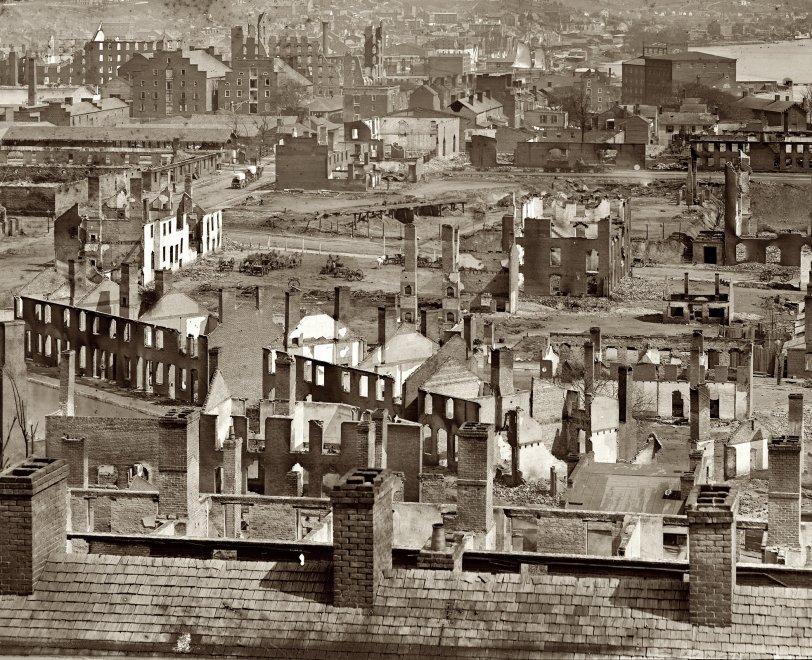


Framed or unframed, desk size to sofa size, printed by us in Arizona and Alabama since 2007. Explore now.
Shorpy is funded by you. Patreon contributors get an ad-free experience.
Learn more.

- Details, Details
- What's that building to the left of the tower?
- Coal Barges
- Bromo-Seltzer
- Inner harbor
- The Basin
- What a headache!
- Giant stepladder?
- Baldwin 62303
- Baldwin VO-1000
- Cold
- No expense spared
- Tough Guys
- Lost in Toyland
- And without gloves
- If I were a blindfolded time traveler
- Smoke Consumer Also Cooks
- Oh that stove!
- Possibly still there?
- What?!?
- $100 Reward
- Freeze Frame
- Texas Flyer wanted
- Just a Year Too Soon
- WWII -- Replacing men with women at the railroad crossing.
- Yes, Icing
- You kids drive me nuts!
- NOT An Easy Job
- I wonder
- Just add window boxes
Print Emporium
Richmond in Ruins: 1865

Richmond, April 1865. Partial view of the burned district. From photographs of the main Eastern theater of war and fallen Richmond compiled by Hirst Milhollen and Donald Mugridge. Detail of wet-plate glass negative. View full size | More.
Quality
I know it's been said before on other photographs on this site; but the quality of the photography from this period is astonishing. The depth of field there is impressive to say the least.
And yeah, I wouldn't want to pick the short straw to go and knock down the remains of those big buildings!
How Did They...?
How did they knock down those burned out mills and warehouses without killing somebody? Some of those precarious brick walls look to be 7 or 8 stories high, I wouldn't like to go near them!
Great website BTW.
Which hill?
Thanks for the link. I was thinking, maybe, Libby Hill?
Weird
I've only lived in Richmond for six months, and seeing photographs like this (especially the "Then and Now" site posted below) really blows my mind. I can't tell you how many times I've gone for a walk and tripped (yes, physically tripped) over a random plaque in the sidewalk that notes that "General SuchAndSuch was carried to this house and died for his cause."
I live in a one-room "studio apartment" (it's actually a carriage house) that was built in 1865 on Church Hill, and it's a really fascinating place to live. There's a trapdoor in my bathroom to a giant (I'd say 6 foot by 6 foot) earthen pit (I don't talk about that room, I assume it was used to store staples, but it's totally the type of place where you might find Hoffa).
Anyway, I can't really tell where the photograph is taken either. Does anybody know what recognizable sections of the city comprised the "burned district"?
Richmond Then and Now
There is a Richmond site "Richmond Then and Now" which does just that--lines up the photosby exact location as much as possible. There were quite a few civil war ones. I can't see any landmarks on this photo here, arpart from the river, of course, but those may be tobacco warehouses across the river, and looking up to Church Hill area?
http://richmondthenandnow.com/
RVA
This is a shot that would be great to have a modern one to compare it with. Check out that ship on the James River, sails all hoisted. Richmond is an interesting city where, in my experience, its native residents spend much time discussing and debating the War. As one who lives in a less destroyed part of the South, it's an odd thing to experience. Still, it's another fascinating place to visit, if folks are looking for such a place to add to a pending travel itinerary.
Funny thing is...
Funny thing is, most of Richmond still looks like this! (I kid, I kid)
What an amazing picture. The artillery battery limbered up but no humans in sight, the burned locomotive with 2 completely burned cars behind it, the schooner under sail, and what looks to be a paddlewheel steamer way off to the right...
How short was the exposure time on something like this? The horses and the covered wagons don't seem to have moved much.
Bombed Cities
What a coincidence: I just finished my profile for my Shorpy user account, where I mentioned I was born in Rotterdam, which had been bombed at the start of WWII in the Netherlands. The first photograph that shows up after the creation of my account is this one of the bombed city of Richmond, the city I asked for details about the state it was in a few days ago, so now I know it is Virginia.
[Indeed. Although Richmond was shelled and burned, not really "bombed." - Dave]
























On Shorpy:
Today’s Top 5